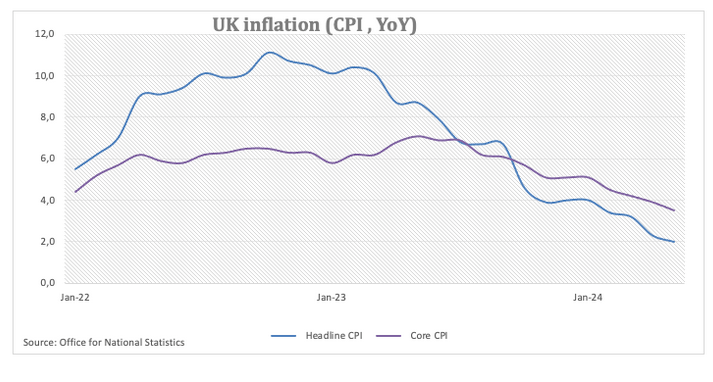The Bank of England (BoE) announced on Thursday that it left the policy rate unchanged at 5.25%, as widely expected.
Developing story, please refresh the page for updates.
Follow our live coverage of the BoE policy announcements and the market reaction.
This section below was published as a preview of the Bank of England rate decision at 07:00 GMT.
- The Bank of England is expected to keep its policy rate unchanged.
- UK disinflationary pressure accelerated in May.
- GBP/USD faces an initial up-barrier at 1.2860.
The Bank of England (BoE) is expected to keep its policy rate unchanged for the seventh consecutive meeting on Thursday, despite the recent acceleration of disinflationary pressures in the UK and speculation of two interest rate cuts this year.
Bank of England could deliver a cautious message
The Bank of England is widely seen maintaining its benchmark interest rate at 5.25% following its policy meeting on Thursday. In addition to the interest rate announcement, the central bank will release its Monetary Policy Minutes.
Despite disinflationary pressures remaining well in place in May, the Bank of England (BoE) appears poised to begin reducing its policy rate at some point in Q4 in response to still highly elevated services inflation (+5.7% YoY vs. +5.3% YoY expected in May).
Furthermore, inflation figures in the UK saw the headline Consumer Price Index (CPI) increasing by 2.0% (down from 2.3%) and the core CPI, which excludes food and energy costs, rising by 3.5% (down from 3.9%). Additionally, it was the first time that the CPI hit the bank’s goal since October 2021.

In addition, money markets now see around 45 bps of easing by the BoE by year-end and nearly 30 bps by November.
Regarding the upcoming event, the latest inflation readings are unlikely to challenge the BoE’s view of starting its easing cycle in the latter part of the year, while a cautious message, particularly highlighting services inflation and the still tight domestic labour market, should not be ruled out just yet.
All in all, the BoE is predicted to hold its policy rate at 5.25% on Thursday at 11 GMT. The vote is anticipated to stay 7-2, with a few revisions to the accompanying statement. It seems likely that traders will be particularly interested in rate recommendations for the August meeting. It is worth recalling that in its May policy decision, the central bank emphasised the importance of upcoming data in formulating decisions on monetary policy.
Following the bank’s event on May 9, Bank of England Governor Andrew Bailey stated that future rate cuts might need to exceed current market expectations to prevent inflation from dropping below target. On Thursday, Bailey remarked that even a small cut to the Bank of England’s interest rate would keep monetary policy in restrictive territory.
Additional comments from BoE officials also saw outgoing Deputy Governor Ben Broadbent, whose final policy decision will be Thursday’s, reportedly maintain that there is a possibility of a summer rate cut. Broadbent indicated that for the BoE to justify lowering rates, the data would need to align with their projections. He also emphasized that he is giving more consideration to services CPI in the short term when making his decision.
His colleague Megan Greene, who had previously noted in April that high wage growth and services CPI indicated inflation persistence, making near-term rate cuts unlikely, has since adjusted her stance. Greene reportedly acknowledged that inflation persistence has lessened, thus omitting the earlier reference to distant rate cuts. Consequently, if forthcoming data further indicate that inflation is decreasing, markets might anticipate Greene voting for a rate cut at the June meeting, contributing to the dovish sentiment from the previous session.
Previewing the BoE gathering, Senior Macro Strategist at Rabobank Stefan Koopman argued that the BoE MPC is expected to maintain the policy rate at Thursday’s meeting. “The vote might again be split, with two members possibly supporting a 25 bps rate reduction. While the MPC is considering lowering interest rates, the current data does not justify such a move. Additionally, the political context makes a pre-election rate cut unnecessarily complicated. We continue to believe that both wage growth and services inflation are not yet consistent with a sustained return to 2% inflation,” he added.
How will the BoE interest rate decision impact GBP/USD?
Even though inflation continued to decline in May, the central bank is unlikely to adopt a more relaxed tone or provide a clearer indication of when interest rates might be reduced. With surprises largely ruled out, the British Pound (GBP) is expected to remain within its current familiar range for the time being.
Against that backdrop, GBP/USD maintains its constructive bias after convincingly surpassing the key 200-day SMA (1.2550). Senior Analyst Pablo Piovano suggests that further gains may lead Cable to revisit the June high of 1.2860 (June 12). Beyond that, the next target is the 2024 top of 1.2893 (March 8) prior to the psychological milestone of 1.3000.
Conversely, Pablo notes that a resurgence of the selling bias could trigger some corrective moves in the short term. Immediate support aligns at the June low of 1.2656 (June 12), closely followed by the provisional 100-day and 55-day SMAs of 1.2639 and 1.2618, respectively. Down from here comes the 200-day SMA at 1.2550. A deeper pullback could put a potential test of the 2024 bottom of 1.2299 (April 22) back on the radar.
